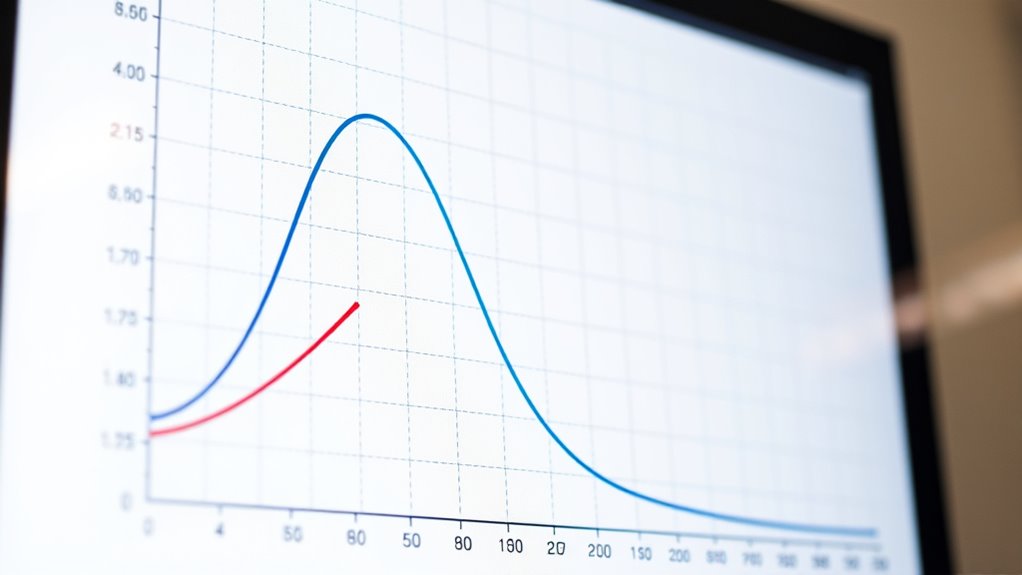To grasp Kaplan–Meier curves like a pro, focus on understanding how they visualize survival probabilities over time, even with censored data. Censoring marks when participant info ends without an event, shown as ticks on the curve. Each step down indicates an event, while censored points don’t cause drops. Mastering how to incorporate censored data accurately guarantees your survival analysis is reliable—continue exploring, and you’ll open deeper insights into interpreting these curves effectively.
Key Takeaways
- Master how censored data points are marked and incorporated to ensure accurate survival estimates.
- Understand that each step downward signifies an event, while vertical ticks indicate censored observations.
- Recognize the importance of properly handling censoring to interpret curves correctly and avoid bias.
- Use survival curves to compare treatment effects, considering how censoring influences the shape and probabilities.
- Practice constructing and analyzing Kaplan–Meier curves to develop confidence and proficiency in survival analysis.

A Kaplan–Meier curve is an indispensable tool in survival analysis that helps you visualize the probability of an event, such as death or disease recurrence, over time. It provides a clear picture of how likely an event is to occur at different points, enabling you to assess treatment efficacy or disease progression. To accurately interpret these curves, understanding censoring techniques is essential. Censoring occurs when a participant’s event status is unknown beyond a certain point, either because they withdraw from the study, are lost to follow-up, or the study ends before they experience the event. By appropriately applying censoring techniques, you guarantee that the survival probability estimates remain unbiased. When constructing a Kaplan–Meier curve, each censored individual is accounted for by marking the time they leave the study without experiencing the event, which maintains the integrity of the survival probability calculations. This method allows you to include partial information from censored data, rather than discarding it, making your analysis more robust. Additionally, understanding how censoring affects the curve helps you interpret the data more accurately and avoid misleading conclusions. As you plot the survival curve, each step downward reflects an event occurrence, while censored data points are represented by small vertical ticks on the curve. These ticks indicate when censoring happens but do not cause the survival probability to decrease. Instead, they signal that at that particular time, some participants were no longer observed, but their data still contribute to the overall survival estimate up until that point. The survival probability at any given time reflects the proportion of individuals who have not experienced the event, adjusted for censored observations. By carefully incorporating censoring techniques, you can produce a more accurate, reliable curve that truly captures the dynamics of your study population. Understanding the interplay between censoring and survival probability helps you interpret your Kaplan–Meier curves confidently. You can discern whether changes in survival probabilities are due to actual events or are influenced by censored data points. This insight is fundamental for making informed clinical decisions or evaluating the effectiveness of interventions. Remember, the key to a meaningful Kaplan–Meier analysis lies in properly handling censored data, guaranteeing your survival probabilities are as precise as possible. Mastering these techniques allows you to leverage the full potential of the Kaplan–Meier method, providing a comprehensive view of survival outcomes over time.
Frequently Asked Questions
How Do I Interpret Confidence Intervals on Kaplan–Meier Curves?
When interpreting confidence intervals on Kaplan–Meier curves, you’re evaluating the precision of survival probabilities over time. They show the range where the true survival rate likely falls, helping you understand the uncertainty. Narrow intervals mean more precise estimates. If hazard ratios are involved, you compare survival outcomes between groups; confidence intervals indicate if differences are statistically significant. Always check if the interval includes the null value to interpret the results accurately.
Can Kaplan–Meier Curves Be Used for Competing Risks Analysis?
Think of your data as a busy intersection with multiple paths. Kaplan–Meier curves, like a single-lane road, don’t track competing risks—other events that can prevent the primary event from occurring. For competing risks analysis, you need specialized curves like cumulative incidence functions, which accurately interpret the probability of each event over time. So, while Kaplan–Meier curves excel for straightforward survival data, they aren’t suited for competing risks curve interpretation.
What Are Common Pitfalls in Constructing Kaplan–Meier Plots?
When constructing Kaplan–Meier plots, you should watch out for common pitfalls like sample bias and improper censoring. Sample bias occurs if your sample isn’t representative, skewing results. Improper censoring happens when you inaccurately record censored data, leading to biased survival estimates. To avoid these issues, guarantee your sample reflects the population and censor data consistently, so your survival curves accurately depict the true event probabilities over time.
How Does Censoring Affect the Accuracy of the Curves?
Censoring can impact the accuracy of your Kaplan–Meier curves by introducing censoring bias and data truncation. When patients are censored, especially if it’s related to the outcome, it can skew survival estimates. You might underestimate or overestimate survival probabilities. Properly handling censored data and understanding its influence helps guarantee your curves reflect the true survival experience, minimizing bias and improving the reliability of your analysis.
Are There Software Tools Specifically Optimized for Kaplan–Meier Analysis?
Imagine wielding a magic wand for your survival analysis—that’s what specialized software tools offer. Yes, there are dedicated programs like SPSS, R (with packages like survival), and SAS optimized for Kaplan–Meier analysis. These tools streamline your work, handle complex censoring, and guarantee accuracy. With this software, you can navigate the data maze confidently, transforming raw numbers into clear, compelling survival stories.
Conclusion
Now that you’ve mastered Kaplan–Meier curves, you’re practically a survival analysis wizard! With these skills, you’ll reveal secrets hidden in data that others only dream of uncovering. Imagine confidently interpreting complex survival stories and making game-changing decisions—no challenge is too big anymore. So go ahead, wield your new knowledge like a superhero cape, and turn every dataset into an epic tale of survival and success. The world of data is yours for the taking!










